少儿英语课堂游戏大全
少儿英语的有趣的课堂游戏教案12篇
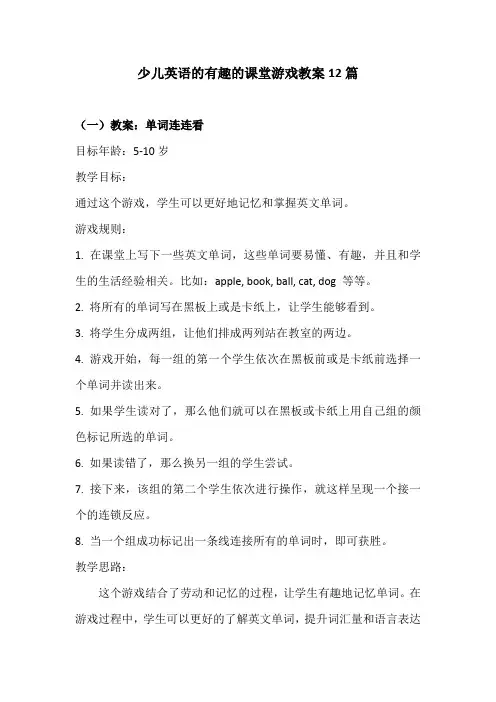
少儿英语的有趣的课堂游戏教案12篇(一)教案:单词连连看目标年龄:5-10岁教学目标:通过这个游戏,学生可以更好地记忆和掌握英文单词。
游戏规则:1. 在课堂上写下一些英文单词,这些单词要易懂、有趣,并且和学生的生活经验相关。
比如:apple, book, ball, cat, dog 等等。
2. 将所有的单词写在黑板上或是卡纸上,让学生能够看到。
3. 将学生分成两组,让他们排成两列站在教室的两边。
4. 游戏开始,每一组的第一个学生依次在黑板前或是卡纸前选择一个单词并读出来。
5. 如果学生读对了,那么他们就可以在黑板或卡纸上用自己组的颜色标记所选的单词。
6. 如果读错了,那么换另一组的学生尝试。
7. 接下来,该组的第二个学生依次进行操作,就这样呈现一个接一个的连锁反应。
8. 当一个组成功标记出一条线连接所有的单词时,即可获胜。
教学思路:这个游戏结合了劳动和记忆的过程,让学生有趣地记忆单词。
在游戏过程中,学生可以更好的了解英文单词,提升词汇量和语言表达能力。
此外,比赛的形式也让学生在轻松愉快的氛围中更好地掌握英语。
(二)教案:字母捉迷藏目标年龄:5-10岁教学目标:通过这个游戏,学生可以更好地记忆英文字母表及其顺序,提高听、说、读、写英语的能力。
游戏规则:1. 使用黄色或白色的标志牌(类似于对弈游戏中的棋子),每个标志牌上印有英文字母表中的一项字母。
2. 将标志牌藏在教室内不同的角落或隐藏在难以发现的地方,比如在椅子底下、桌子上、地板下等位置。
3. 将学生分为两到三个小组,每个小组分别选出一个“小队长”。
4. 游戏开始,每个小组的小队长依次去寻找标志牌,并尽量记住所寻找到的字母顺序。
5. 当小队长找到标志牌后,需大声高唱出标志牌上的字母,并将其收集起来。
6. 最终所有小组收集到的标志牌要按照英文字母表的顺序排列,第一个完成的小组即为胜利者。
教学思路:这个游戏鼓励学生积极参与,通过追逐、探险的过程中边玩边学,提高了学生的英语听、说、读、写的能力。
儿童英语游戏100种有趣的课堂英语小游戏
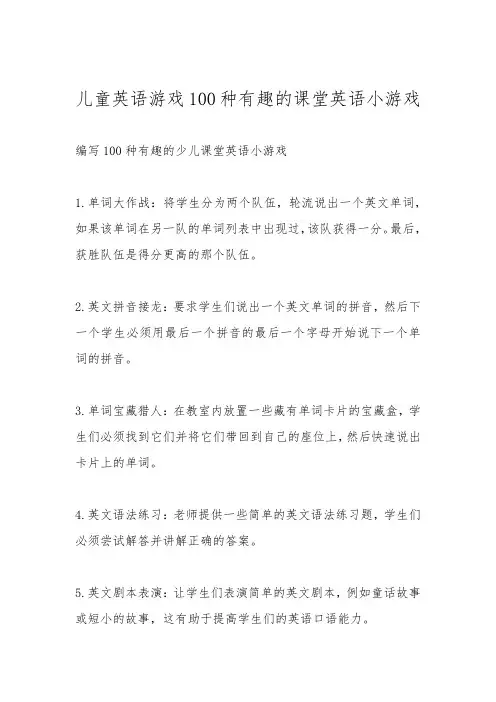
儿童英语游戏100种有趣的课堂英语小游戏编写100种有趣的少儿课堂英语小游戏1.单词大作战:将学生分为两个队伍,轮流说出一个英文单词,如果该单词在另一队的单词列表中出现过,该队获得一分。
最后,获胜队伍是得分更高的那个队伍。
2.英文拼音接龙:要求学生们说出一个英文单词的拼音,然后下一个学生必须用最后一个拼音的最后一个字母开始说下一个单词的拼音。
3.单词宝藏猎人:在教室内放置一些藏有单词卡片的宝藏盒,学生们必须找到它们并将它们带回到自己的座位上,然后快速说出卡片上的单词。
4.英文语法练习:老师提供一些简单的英文语法练习题,学生们必须尝试解答并讲解正确的答案。
5.英文剧本表演:让学生们表演简单的英文剧本,例如童话故事或短小的故事,这有助于提高学生们的英语口语能力。
6.拼写接龙游戏:老师给出一个英文单词,学生们必须在规定的时间内写出尽可能多的以该单词的最后一个字母开头的英文单词,拼写正确得分。
7.单词卡片匹配游戏:将一些单词卡片打印出来,学生们必须将它们正确地匹配到相应的图片上。
8.说故事游戏:老师开始讲一个简短的故事,然后学生们必须继续讲下去,这有助于提高学生的英语口语能力和想象力。
9.词汇接龙游戏:老师说出一个单词,学生们必须在规定的时间内说出尽可能多的与该单词相关的英文单词,例如同义词、反义词、相关词等。
10.英文歌曲听辨游戏:放一首英文歌曲,学生们必须尝试听出歌词,并将歌曲中的单词填入一张工作表中,以此来提高他们的英语听力和阅读能力。
11.拼图游戏:将一些英文单词打印在拼图上,学生们必须将拼图正确组合成单词,并说出单词的意思或用法,以此来加强他们的英文拼写和理解能力。
12.语言障碍游戏:要求学生们说英语,但在说话时添加语言障碍,例如说话时必须拍手或倒退等,这有助于提高学生们的语言灵活性和创造力。
13.单词拼图游戏:将一些英文单词打乱顺序,学生们必须将它们重新排列成正确的单词,并说出单词的意思或用法。
小学英语课堂小游戏集锦
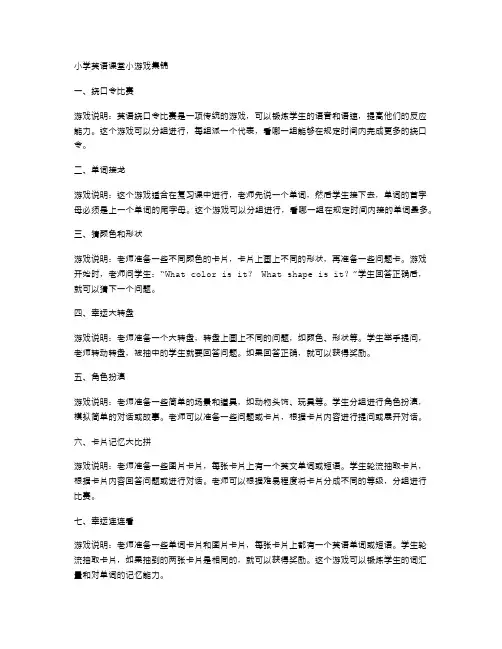
小学英语课堂小游戏集锦一、绕口令比赛游戏说明:英语绕口令比赛是一项传统的游戏,可以锻炼学生的语音和语速,提高他们的反应能力。
这个游戏可以分组进行,每组派一个代表,看哪一组能够在规定时间内完成更多的绕口令。
二、单词接龙游戏说明:这个游戏适合在复习课中进行,老师先说一个单词,然后学生接下去,单词的首字母必须是上一个单词的尾字母。
这个游戏可以分组进行,看哪一组在规定时间内接的单词最多。
三、猜颜色和形状游戏说明:老师准备一些不同颜色的卡片,卡片上画上不同的形状,再准备一些问题卡。
游戏开始时,老师问学生:“What color is it? What shape is it?”学生回答正确后,就可以猜下一个问题。
四、幸运大转盘游戏说明:老师准备一个大转盘,转盘上画上不同的问题,如颜色、形状等。
学生举手提问,老师转动转盘,被抽中的学生就要回答问题。
如果回答正确,就可以获得奖励。
五、角色扮演游戏说明:老师准备一些简单的场景和道具,如动物头饰、玩具等。
学生分组进行角色扮演,模拟简单的对话或故事。
老师可以准备一些问题或卡片,根据卡片内容进行提问或展开对话。
六、卡片记忆大比拼游戏说明:老师准备一些图片卡片,每张卡片上有一个英文单词或短语。
学生轮流抽取卡片,根据卡片内容回答问题或进行对话。
老师可以根据难易程度将卡片分成不同的等级,分组进行比赛。
七、幸运连连看游戏说明:老师准备一些单词卡片和图片卡片,每张卡片上都有一个英语单词或短语。
学生轮流抽取卡片,如果抽到的两张卡片是相同的,就可以获得奖励。
这个游戏可以锻炼学生的词汇量和对单词的记忆能力。
八、英语歌曲接龙游戏说明:老师播放一首简单的英文歌曲,学生轮流接唱后面的歌词。
如果学生唱错了或者不准确,就要接受一个小小的惩罚。
这个游戏可以锻炼学生的语音和语调,提高他们的英语学习兴趣。
九、你画我猜游戏说明:老师准备一些简单的英语单词或短语卡片,将学生分成两组,每组派出一名学生根据卡片内容进行表演或绘画,其他学生猜出单词或短语。
14个英语互动小游戏,教孩子轻松学英语
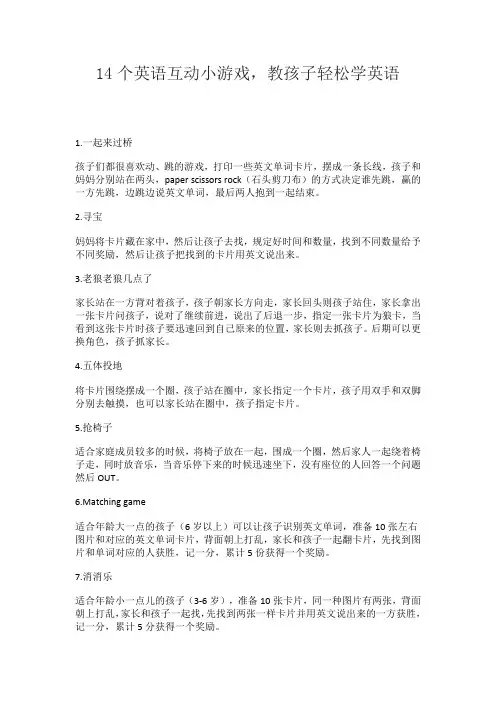
14个英语互动小游戏,教孩子轻松学英语
1.一起来过桥
孩子们都很喜欢动、跳的游戏,打印一些英文单词卡片,摆成一条长线,孩子和妈妈分别站在两头,paper scissors rock(石头剪刀布)的方式决定谁先跳,赢的一方先跳,边跳边说英文单词,最后两人抱到一起结束。
2.寻宝
妈妈将卡片藏在家中,然后让孩子去找,规定好时间和数量,找到不同数量给予不同奖励,然后让孩子把找到的卡片用英文说出来。
3.老狼老狼几点了
家长站在一方背对着孩子,孩子朝家长方向走,家长回头则孩子站住,家长拿出一张卡片问孩子,说对了继续前进,说出了后退一步,指定一张卡片为狼卡,当看到这张卡片时孩子要迅速回到自己原来的位置,家长则去抓孩子。
后期可以更换角色,孩子抓家长。
4.五体投地
将卡片围绕摆成一个圈,孩子站在圈中,家长指定一个卡片,孩子用双手和双脚分别去触摸,也可以家长站在圈中,孩子指定卡片。
5.抢椅子
适合家庭成员较多的时候,将椅子放在一起,围成一个圈,然后家人一起绕着椅子走,同时放音乐,当音乐停下来的时候迅速坐下,没有座位的人回答一个问题然后OUT。
6.Matching game
适合年龄大一点的孩子(6岁以上)可以让孩子识别英文单词,准备10张左右图片和对应的英文单词卡片,背面朝上打乱,家长和孩子一起翻卡片,先找到图片和单词对应的人获胜,记一分,累计5份获得一个奖励。
7.消消乐
适合年龄小一点儿的孩子(3-6岁),准备10张卡片,同一种图片有两张,背面朝上打乱,家长和孩子一起找,先找到两张一样卡片并用英文说出来的一方获胜,记一分,累计5分获得一个奖励。
少儿英语:45种有趣的课堂游戏
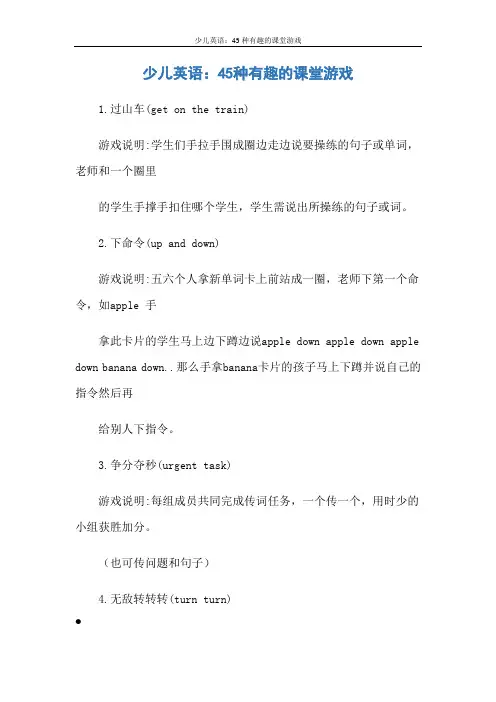
少儿英语:45种有趣的课堂游戏1.过山车(get on the train)游戏说明:学生们手拉手围成圈边走边说要操练的句子或单词,老师和一个圈里的学生手撑手扣住哪个学生,学生需说出所操练的句子或词。
2.下命令(up and down)游戏说明:五六个人拿新单词卡上前站成一圈,老师下第一个命令,如apple 手拿此卡片的学生马上边下蹲边说apple down apple down apple down banana down..那么手拿banana卡片的孩子马上下蹲并说自己的指令然后再给别人下指令。
3.争分夺秒(urgent task)游戏说明:每组成员共同完成传词任务,一个传一个,用时少的小组获胜加分。
(也可传问题和句子)4.无敌转转转(turn turn)游戏说明:两名同学到前面背靠背站好,手中各持一张单词卡。
在老师下口令后快速旋转,最先说出对方卡片单词的同学获胜。
5.点手掌(catch the finger)游戏说明:说单词时让孩子点老师的手掌,老师来抓。
6..魔力手指(magic finger)游戏说明:先规定好每根手指说的遍数,然后用书挡住让同学猜是哪一个。
7.五体投地(body)游戏说明:把单词卡片放在地上,然后用身体的各个部位去接触,孩子特别喜欢。
8.抢椅子(get the chair)游戏说明:老师在教室前面摆三个椅子,然后叨四个小朋友到前面来,然后老师和学生一起读这个单词或句子,当老师停下来的时候学生就要去抢椅子,没抢到椅子的学生就要被罚读一个单词,然后回去。
9.相反劢作(opposite actions)游戏说明:(适吅单词的整体操练)老师上下前后左右拍手说单词,学生要和老师的劢作相反,如相同则给那组减分。
10.谁最快(who is the best?)游戏说明:(适吅单词的总体操练),老师说one two go 老师手中卡片如果是平放的,学生们就坐着说单词,如果卡片是立起来放的学生就立刻站起来说,谁最快就给他奖励。
少儿英语游戏大全
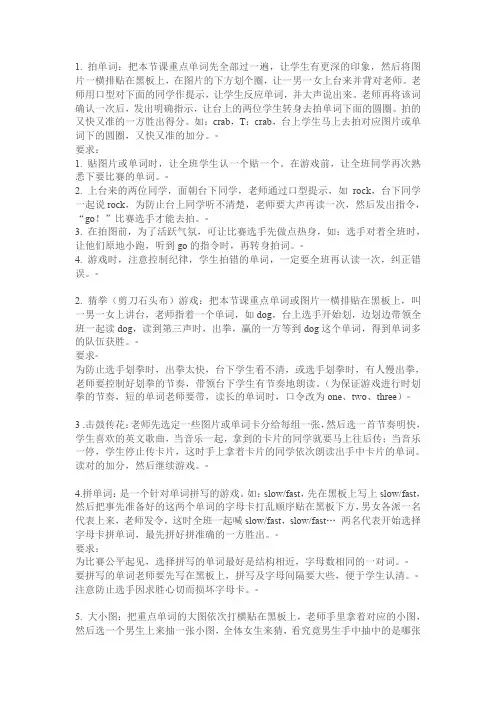
1. 拍单词:把本节课重点单词先全部过一遍,让学生有更深的印象,然后将图片一横排贴在黑板上,在图片的下方划个圈,让一男一女上台来并背对老师。
老师用口型对下面的同学作提示,让学生反应单词,并大声说出来。
老师再将该词确认一次后,发出明确指示,让台上的两位学生转身去拍单词下面的圆圈。
拍的又快又准的一方胜出得分。
如:crab,T:crab,台上学生马上去拍对应图片或单词下的圆圈,又快又准的加分。
要求:1. 贴图片或单词时,让全班学生认一个贴一个。
在游戏前,让全班同学再次熟悉下要比赛的单词。
2. 上台来的两位同学,面朝台下同学,老师通过口型提示,如rock,台下同学一起说rock,为防止台上同学听不清楚,老师要大声再读一次,然后发出指令,“go!”比赛选手才能去拍。
3. 在拍图前,为了活跃气氛,可让比赛选手先做点热身,如:选手对着全班时,让他们原地小跑,听到go的指令时,再转身拍词。
4. 游戏时,注意控制纪律,学生拍错的单词,一定要全班再认读一次,纠正错误。
2. 猜拳(剪刀石头布)游戏:把本节课重点单词或图片一横排贴在黑板上,叫一男一女上讲台,老师指着一个单词,如dog,台上选手开始划,边划边带领全班一起读dog,读到第三声时,出拳,赢的一方等到dog这个单词,得到单词多的队伍获胜。
要求为防止选手划拳时,出拳太快,台下学生看不清,或选手划拳时,有人慢出拳,老师要控制好划拳的节奏,带领台下学生有节奏地朗读。
(为保证游戏进行时划拳的节奏,短的单词老师要带,读长的单词时,口令改为one、two、three)3 .击鼓传花:老师先选定一些图片或单词卡分给每组一张,然后选一首节奏明快,学生喜欢的英文歌曲,当音乐一起,拿到的卡片的同学就要马上往后传;当音乐一停,学生停止传卡片,这时手上拿着卡片的同学依次朗读出手中卡片的单词。
少儿英语课堂游戏
游戏二、看谁快 (乌龟翘)两个人背对背,老师把卡片分别发给两人,两人手拿卡片必须把卡片向外,并且先不能说出自己的卡片是什么。
当老师说“1,2,3”时,数到3,两人要同时转身,谁先读出来了谁就获胜,输的淘汰,让其他人来挑战获胜者,最后决出总冠军。
游戏三、爬楼梯可分成两组,画好一个梯子,准备一个色子,两组分别掷色子,哪组点数大老师就先问哪一组的任一一个队员问题,回答出来了,这组爬一层楼梯,没回答出来的就不加分或给对方加分。
哪方最先到终点哪方获胜游戏四、Paper Scissor Stone剪刀石头布两人一组,剪刀石头布。
如果哪方赢了,就在一叠单词中间抽一张卡片,说出来的话那张卡片就归他。
没说出来就不能拿。
最后看哪组个的卡片最多哪个就赢了。
游戏六、听口令看谁写得快老师叫两个学生上来,给两人一只笔,两人必须背对着黑板,老师说一个单词或一个数字,听到以后,两人必须把听到的写到黑板上,谁写的又快又准确谁就赢。
游戏九、击鼓传花Passing down传一样东西,敲鼓的人说停花落在谁那儿谁就要说一个学过的单词。
游戏三、Bomber man炸弹人老师要教多个单词。
首先,出示一个数字(迅速地)给学生看,告诉他们出示的数字就意味着第几个单词下有地雷,不要跟读。
如果谁读了那么大家就一起来炸他。
游戏13. Magic fingers1.传统玩法2.加减法3.复读机4.减1游戏二、快速记忆法(可以放在手上几张卡片来猜)把4,5张刚学过的卡片放在地上,让学生记住卡片的位置,给足时间“十秒”,十秒倒计时过后,老师把卡片全部翻转过来,然后随便指一张问学生是什么单词,猜对了有奖励,如果学生做得很好,可以增加难度,同时说两张。
游戏十九、抢凳子玩法1 将学生分成两组,将字母卡片发给每个学生,老师说出三个字母,代表这三个字母的六位学生出列围成一圈抢凳子,一组三人都抢到的加分。
玩法 2 先将所有学生围着凳子站一圈,然后,老师或领头的学生带领身后的人边转圈边唱歌谣或者歌曲,接着,在绕圈的途中老师或领头的学生突然喊“Stop!”,学生们便马上去抢凳子,最后没有抢到的就出局,应该表演节目。
少儿英语:50种有趣的课堂英语小游戏
少儿英语:50种有趣的课堂英语小游戏以下是50种有趣的少儿英语课堂游戏,可以激发学生的兴趣,增强他们的英语语言技能。
1.拼单词游戏:准备一些字母卡片,学生需要将字母组成正确的单词。
2.谁是谁的同伴:学生们分成小组,每组要根据给出的描述找到自己的“同伴”。
3.隐藏单词:老师在教室内隐藏一些单词,学生们需要找到它们并快速读出来。
4.快速口算:老师随机出一个数字,学生们需要快速计算出它的加减乘除结果。
5.英语版石头剪刀布:用英语数数并喊出自己的选择,例如“1、2、3,rock”。
6.英语歌曲卡拉OK:播放英文歌曲,学生们跟着歌曲唱,可以让他们学习新词汇和发音。
7.字母联想游戏:老师说出一个单词,学生们需要说出与之相关的单词,例如“apple”会联想到“fruit”。
8.绘画游戏:老师给出一个英文单词,学生们需要画出相关的图形。
9.接龙游戏:学生们轮流说出一个英文单词,下一个学生需要接着上一个单词的最后一个字母说出新的单词。
10.词语追逐游戏:学生们分成两组,轮流说出英文单词,下一个学生需要接着上一个单词的第一个字母说出新的单词。
11.给单词分组:老师将单词分成不同的组,学生需要根据给出的提示将单词归类到正确的组别中。
12.听写游戏:老师快速朗读单词,学生需要尽可能多地听写出正确的单词。
13.单词匹配游戏:准备一些单词卡片,学生们需要将相同的单词配对。
14.单词排列游戏:学生们需要将字母卡片按照正确的顺序排列,组成正确的单词。
15.抢答游戏:老师随机出一个问题,学生们需要尽快按下答题器抢答,回答正确的学生会得到相应的分数。
16.单词串联游戏:老师给出一个单词,学生们需要根据给出的提示,将与之相关的单词串联在一起,例如“dog”会串联到“bark”和“puppy”。
17.记忆游戏:老师展示一些单词或图片,学生们需要记住它们,然后在一定时间内回忆出来。
18.单词拼写比赛:老师快速读出一个单词,学生们需要尽快拼写出来,拼写正确的学生会得到相应的分数。
儿童英语游戏100种有趣的课堂英语小游戏
儿童英语游戏100种有趣的课堂英语小游戏1.音乐热身:让孩子们在欢快的音乐中跳舞,同时重复英文数字、字母或基本表达,如数数、问候等。
2.魔术词语:请每个孩子选择一个英文单词,并将其告诉老师。
然后,老师将收集这些单词并随机选择一个,其他孩子需要猜测这个单词是什么。
3.建筑砖块:使用卡片或磁贴,上面写有不同的单词。
孩子们需要根据给定的主题或要求,将这些单词组合成句子或故事。
4.动物骗子:老师扮演“动物骗子”,描述一个不存在的动物,并询问孩子们关于该动物的问题。
孩子们需要用英语提问和回答。
5.单词挑战:每个孩子依次说一个英文单词,该单词必须以前一个单词的最后一个字母开头。
如果孩子不能想出一个合适的单词,他们就会被淘汰。
6.隐藏物品:老师藏起一个物品,并用英文提示指导孩子们找到它。
例如,"It's under the chair." (它在椅子下面)7.报纸字母:给每个孩子一张报纸,并要求他们找到尽可能多的英文字母,然后按顺序排列。
8.表演时间:让孩子们分成小组,每个小组准备一个简短的英语表演,可以是故事、歌曲或角色扮演。
9.飞镖游戏:在教室中贴上英文字母或单词的标志,让孩子们用软质飞镖射中他们熟悉的字母或单词,并用英文读出来。
10.猜猜我是谁:每个孩子在背上贴上一张纸,上面写有一个英文单词。
然后,孩子们互相提问问题,以找出他们背上的单词是什么。
11.穿越隧道:在教室中设置一条“隧道”,使用桌子、椅子等物品。
孩子们需要从隧道中爬过,同时说出他们所见到的英文单词。
12.电视新闻:让孩子们分成小组,模拟新闻节目,并用英语报道当天的新闻。
可以提供一些简单的新闻主题供他们选择。
13.排列游戏:给孩子们一些字母卡片,要求他们尽可能多地组成不同的英文单词。
14.唱唱跳跳:教唱一首简单的英文歌曲,并加上一些动作。
孩子们跟着歌曲和动作一起唱唱跳跳。
15.词语接龙:每个孩子说一个英文单词,下一个孩子需要用与前一个单词的最后一个字母开头的单词继续接龙。
儿童英语课堂游戏大全.
儿童英语课堂游戏1、“碰地雷”:在英语单词教学中,学生不太愿意跟读。
用此法不错。
在一个词下放一个地雷,这个词是不能读的,如果学生不小心跟读,就是踩到雷了。
大家一起数one two three,bomb,向他砸过去!有趣,气氛也好,学生在玩中也学得扎实!2、补全句子:在学习句中,要慢读,必要时分解读。
在跟读几遍后,可以让学生补全老师没说完的部分。
比如:my name is rebecca.可让学生补rebecca、is rebecca、name is rebecca。
这是个反应练习,可让学生熟练掌握句子。
3、此呼彼应:(1)全班学生坐在原位。
(2) 教师描述一些事物,如果的是对的,例如:The dusks are swimming.学生就学叫“嘎嘎”,如果的是错的,学生就保持沉默。
(3) 做错的学生暂且退出游戏。
游戏继续进行。
(4) 剩下的一个学生即游戏的优胜者。
(5) 变化:The bike is coming .或A cat can run. 等。
(6) 作用:可用于现在进行时态和can 句型的教学,可训练学生的听力。
4、拍皮球:(1) 学生分两组坐在原位,合上眼,教师为两组打分。
(2) 教师拍皮球,学生默数教师拍了几下。
假设教师拍了19下。
(3) 教师突然停下,问一个学生:“What’s the number?”该学生应该答,“Nineteen”。
如果他答对了,该组得分,并由该学生接替教师拍球,游戏继续进行,如果他讲错了,就让别的学生纠正。
(4) 哪组学生得分多,就为胜者。
(5) 变化:教师拍球时可以在中间来个停顿。
如先拍4下,停一停,再拍3下,接着问:“What’s the number?”学生应答“Seven”或“Four plus three is seven.” (6) 作用:操练数词和加法运算句型。
5、加减连算:(1) 学生分成两组,互相出题,教师仲裁打分(2) 由A组第一个学生先出题,如:Five plus five ……B 组第二个学生必须立即回答:Five plus five is ten.然后由该生再接下去,如:Minus four, A组第二个学生再接着答题Ten minus four is six.如果讲错,该组就扣分。
- 1、下载文档前请自行甄别文档内容的完整性,平台不提供额外的编辑、内容补充、找答案等附加服务。
- 2、"仅部分预览"的文档,不可在线预览部分如存在完整性等问题,可反馈申请退款(可完整预览的文档不适用该条件!)。
- 3、如文档侵犯您的权益,请联系客服反馈,我们会尽快为您处理(人工客服工作时间:9:00-18:30)。
Games1.Letters:ABC erase:Once the students know the alphabet, you can use this game for a simple review. Start off with the whole class reading the alphabet together. Choose a student to come to the whiteboard and erase one or two random letters. Have the class read the alphabet again, but when they com to erased letters they have to clap hands(or stomp feet). Continue until there are no letters left.Matching:Have two columns on the whiteboard – one for capital letters and the other for lower case letters. Students must come to the board and draw a line to matching letters and say the letter.Ex.A cB aC bTiming:Time the class as they read the alphabet. Give them a time they must aim to reach. Write the matching letter:Write capital letters on the whiteboard and have students come to the whiteboard to write the correct lower case form of the letter.Ex. A_ B_ C_ D_ …Team alphabet writing:Have the students line up in front of the whiteboard. The first student will write the letter ‘A’ then hand the marker to the next student who will write the letter ‘B’ and so on.26 pick-up:Scatter the alphabet flashcards on the floor and have a student put them in the correct order. Can be done individually or with two or three students working together.2.SpellingUnscramble the letters:Write a word incorrectly on the whiteboard and have two or three students come to the whiteboard and unscramble the letters.Ex. plape appleAdd on writing:Have a student write a word on the whiteboard and then have the next student write a word starting with the last letter of the first word and so on.Ex. bikeggirlucky…Words that start with:Have students come to the whiteboard and tell them to write as many words that start with (selected letter) in one minute.Ex. A –apple, ant, angry, August, and…Missing letters:To practice long vowels or letter combinations write a word on the whiteboard with two or three letters missing. The student must listen to what you say and write the correct letters.E x. b_k_ The student must listen to hear if the teacher says ‘bike’ or ‘bake’.Ex. sh__t The student must listen to hear if the teacher says ‘shirt’ or ‘short’.Tenses:Write a word in the present tense and then have a student write the past and/or present continuous(or another tense).Past Present Present Continuous(Progressive)ate eat eatingTeam Spelling:Have students stand in front of the whiteboard. You say a word and they must each writea letter to form the word.3.Vocabulary(Recognition)Memory: Prepare two cards for each selected key word. You can create different types of matching cards to practice different areas.i)find the matching word Ex. dog → dogii)word → picture Ex. apple →iii)opposites Ex. happy → sadiv)tenses Ex. swim → swamHave at least five words(⨯ 2) put onto cards.*Extension: Have the students make a sentence with the word they match.PICTURESee last training.Words on dice:Place key words on the dice and have the students roll the dice. They must read and/or make a sentence with the word that appears.Hangman:The students must answer a question and then guess what letter they think is in the word. PICTURETeam Tic-tac-toe:1.Student throws a sticky ball at the chart on the whiteboard and reads word and/ormakes a sentence with the word to win the space.2.If they are correct, they place/draw their team logo in space.Name Game:Class stands in a circle with one student in the middle(Ex. Michael). Michael closes his eyes an d spins in a circle while his classmates chant, “Michael, Michael, what can you do?” Michael responds, “I can point to ____.” Opens his eyes and says the student’s name he is pointing at. Michael then sits down and the student he called on moves into the middle.PICTURETouch:To practice colors/classroom objects/body parts. The teacher says “Touch pink with your elbow.” Or “Touch the wall with your bum.” Students listen to the instructions and race to touch what the teacher said.*Safety first! Don’t let them push each other.Create a loop on flashcards using pipe cleaner and have a ‘fishing rod’ with a hook. The students have to read and/or make a sentence with the word they ‘hook’. Can have the rest of the class ask that student a question related to the word.Numbers:Have two boxes – one with object flashcards and the other with number flashcards. For example, to review body parts have a student draw a flashcard from the ‘body parts’ box. The class asks that student, “How many noses do you have? The student draws a flashcard from the number box and makes a sentence –“I have 56 noses.”PICTURECrossword Puzzle:Beginner: Have a list of words that the students must place into the correct spaces in the crossword puzzl e. You do not have to indicate whether the word is ‘Across’ or ‘Down’. Advanced: Have a description of a word they have studied. The students will have to remember the word and then write it in the correct spaces. You must have the descriptions in two columns –one for ‘Across’ and one for ‘Down’. You will also haveto have a number next to the description that matches the space it should be placed on the crossword puzzle.PICTURE4.Writing3 on the board: Choose two or three students to come to the whiteboard. First have them turn their backs to the whiteboard so that you can write the question without them seeing. When you tell them to turn around, they will write the answer as quickly as possible. The first student to finish gets 3 stars, the second 2 stars and the third 1 star if they have written everything correctly.Unscramble the words: Again, you can choose two or three students to do this activity at the same time. Write a sentence with the words written in an improper order. The students must re-write the sentence, correctly, as quickly as possible.Ex. game I to play want a.I want to play a game.Tense change: Have two or three students standing with their backs to the whiteboard. Write a sentence on the whiteboard and then tell them what tense they have to change it to.Ex. T: I always swim on Saturday. (Change it to past tense)ST: I swam last Saturday.Questions: Divide students into groups of three or four. Tell them to write as many questions as possible in __ minutes. You can allow them to write random questions or assign a topic. For example, choose ‘food’ as the topic. The students have to write questions that are related to food. After the time is up, you can mark their questions in a variety of ways. You correct them by yourself; have the groups exchange papers and correct them; write them on the whiteboard and correct them as a class.5. Questions3 to 1: Every student has to think of two questions. When they are ready, have a groupof four students stand up. The first three students will ask the fourth one question each.If the student answers correctly he/she gets a star. If the student answers incorrectly, the student who asked the question gets a point. There are only four students active in this game so you should keep it short. Have one or two groups perform this activity in one lesson. You can have the other students listening for mistakes.PICTUREWhat’s missing?: Have selected objects placed on the desk you are sitting at. Have twoor three students, standing at the desk, turn their backs to you. You remove one object then have them turn around and ask you questions to find out which object you removed. For example, if the topic is ‘Sports’ you would have sport-related flashcards on the table and the students could ask you sport-related questions: Can you play baseball? Are you swimming? Do you like to play basketball?Class questions:Choose a topic such as ‘Food’. The class, as a whole, will have to create as many questions as possible. You write them on the whiteboard as they say them. When the time is up, review the questions together and have the students point out any mistakes. Keep a record of the number of correct questions they asked you. As they improve you can show them past results so they can see their own progression.I Spy:T: I spy with my little eye something ‘blue’.ST: Is it a book?/Is it a pen?You can review a lot of objects with this activity and you can also have the students practicing how to ask questions.Survey: Give a handout, with a list of questions, to every student. They must go around the class and ask their classmates these questions(first person). When they have completed all the questions, they show you. You then ask them questions in the third person.6. SpeakingMastermind: Choose one student to be the ‘Quiz Master’ and choose three or four‘contestants’. Have the rest of the class divided into groups of three or four. Assign one of three topics to each group to prepare; spelling/questions/answersAfter they have completed their task, have group place their pieces of paper in appropriate box.(spelling box/questions box/answers box)There are three rounds to this game. The ‘contestants can choose one of t he three categories for each round. The ‘Quiz Master’ will draw a piece of paper from the selected category box and then ask that question.Ex. Spelling: How do you spell giraffe?Question: Where is your pencil box?Answer: I like to play baseball.(Make a question)Quick questions: This is a good review activity to do at the beginning of class. Have three or four lists of ten questions. Choose a student and ask them ten questions quickly. Record their performance and then have the student write the question(s) and answer(s) they got wrong as extra homework. You can let the students know in advance when they will be participating in this activity. Only have three or four students do this activity in each lesson.。
